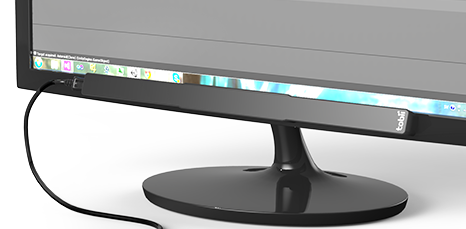During Ars' review playthrough of the latest adventure in the Deus Ex series, I spied a curious option tucked into its Windows menus: "Tobii eye-tracking." None of Square Enix's press materials mentioned such a thing, which seemed strange for a series that revolves around human augmentation and sci-fi upgrades. Eye-tracking in an FPS? Sounds like some futuristic stealth-spy stuff!
The word "Tobii" perked up my coworkers' ears, as they'd tested simple prototypes of the eye-tracking doodad at various Consumer Electronics Shows. Deus Ex presented a great opportunity to test the add-on's full potential, and Tobii was kind enough to send loaner hardware. We wanted to find out: Just what does an eye-tracking sensor do for computer users—how does it translate the gaze of your eyes to real-world computer use—and does it work well enough to earn a $140 price tag?
Angle and orientation woes
-
Tobii EyeX, lights on. These stay on during normal use, but they didn't hurt my eyes while testing.
-
EyeX, lights off.
-
A Tobii illustration shows how eye-tracking works.
-
EyeX, all split up.
The Tobii EyeX tracker comes in one shape, one size: wide and thin, with three giant, red IR sensors that loudly light up when plugged into a PC's USB 3.0 port. The tracker ships with two little magnets, and they both come with adhesive stickers on one side; stick them to the bottom of your monitor, then stick your EyeX onto them. Install a set of drivers and a Windows software suite, and you're set.
The EyeX's first major limitation comes during installation. It's very picky about how you position your PC monitor of choice. To function properly, your monitor has to be one arm's length away from your face, and the EyeX must be able to look at an upward angle to see your eyes. If your desk or table is set up in such a way that your monitor isn't perfectly at eye level, the EyeX won't see your eyes. The device's setup phase doesn't offer any advice other than "adjust the angle."

Well, you can't. Tobii's magnet-connection rig doesn't let you change the sensors' direction, let alone the angle in case you accidentally mis-stick the magnet's very sticky adhesive strip unevenly (which is very possible, considering it's an all-black magnet, and you're probably sticking this thing to a dark or black monitor bezel). The only course of action you have is to raise or lower your entire monitor. In my case, I raised my Asus screen with a board-game box. I opted for Splendor, and it's a damned fine game, if you're wondering.
I'd love for future Tobii releases to charge a few more bucks for a more tunable attachment. My other preference—sitting on my couch for living-room PC gaming—would require a very different kind of Tobii tracker, since the EyeX needs to be pretty close to a player's eyes.
reader comments
79